Lea Wait's Blog, page 39
May 10, 2024
A QUESTION THAT SOMETIMES FLITS THROUGH MY MIND
by Jule Selbo

James Lee Burke, age 87 now, is an American author who we know from the David Robicheaux series (17 books so far, by my count) and the Sheriff Hackberry Holland series (13 books by my count). He’s got a few Edgar Awards and he’s been presented with the Grand Master Award from the Mystery Writers of America, he’s got a CWA Diamond Dagger and a Gold Dagger and the Grand Prix of Litterature Policiere and he’s a recipient of the Guggenheim Fellowship for Creative Arts in Fiction. Some of his other books are historical fiction, some are collections of short stories about love and honor and survival, some are coming-of-age tales. He earned his Master’s in English and taught at universities and the Job Corps, served as a case worker for felons and the criminally insane, worked as a pipeliner, newspaper reporter, and long-distance truck driver. A NY Times reviewer suggested his work is a bit like Faulkner, a bit like Sartre and – then, of course, a lot like James Lee Burke.
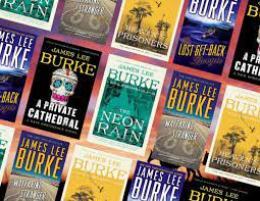
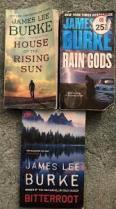 I was excited to see he wrote an introduction to a crime/mystery book I was reading and settled in to see what he had on his mind. This is what he wrote (I am cherry- picking the best parts, the ones that resonated the most to me):
I was excited to see he wrote an introduction to a crime/mystery book I was reading and settled in to see what he had on his mind. This is what he wrote (I am cherry- picking the best parts, the ones that resonated the most to me):
James Burke: “I have always been puzzled by our collective tendency to place American writing into categories, particularly when the categorical description is not meant to be complimentary… Terms like ‘mystery’ and to some degree ‘crime’ fiction have connotations that may not be derogatory but are hardly laudable, at least not laudable in the way the categorical terms ‘literary’ fiction and ‘metaphysical’ poetry, and my all-time favorite, ‘metafiction’ are used.”
Burke continues: “Academics do not teach James M. Cain, even though he is one of our best writers – his novel Mildred Pierce is arguably as good as any book Henry James wrote using a female protagonist. By the same token, I would suspect most academics would probably not want to call Robert Stone’s Dog Soldiers a crime novel, even though its subject is heroin smuggling and the moral insanity of a profligate society. Why not? You got me. Perhaps books that win the National Book Award are automatically excluded from the crime-novel category….
More Burke: Edna Buchanan and I both blurbed for The Black Echo (by Michael Connelly). I’d like to quote from my words…

‘…one of the most authentic pieces of crime writing I’ve ever read. When Connelly takes you into a tunnel beneath the earth, either in Los Angeles of Vietnam, you feel that you’re entering a domain of moral darkness that only Joseph Conrad could adequately describe…’
Continuing to quote Burke: “We forget sometimes that the genre begun by Edgar Allan Poe was actually a metaphor, at least for Poe, about the decay of Western civilization. James M. Cain once said that the premise of all his plots was the tragedy that befalls us when we eventually get what we want…”
Now this is just me, Jule: Just some of the “oldies” I admire that got me into the crime/mystery genre when I was a kid: John Fowles, Martin Cruz Smith, Graham Greene, P.D. James, Patricia Highsmith, John Le Carre, James M. Cain, Umberto Eco, James Lee Burke, Daphne Du Maurier, and a whole whole whole bunch more.
Among the hall-of-famers of my crime/mystery youth:






Le Carre…Smith… duMaurier… Fowles………. Highsmith….. Cain





Eco…. Greene………… Christie…. Chandler …. P.D. James
As a lifelong reader of all genres, I am continually gobsmacked when I hear (or overhear) the denigration of the crime genre, the romance genre, the horror genre, disaster genre, western genre, comedy (humor) genre and others – those that are not embraced under ‘literary fiction’. Novelists dedicated to examining the whys and wherefores of characters and situations, of good and evil, or morality and immorality, of ethical and unethical behaviors – for me, it’s all one stewpot. And that’s what my favorite books explore.
I can appreciate all sorts of stories, but I am partial to crime/mysteries because of their strong story engines, the creation of actions that garner great consequences, the building of puzzles of who-done-what-and-why, the examinations of malfeasance and evil and selfishness and of those who try to find some semblance of justice in the world.
Like James Lee Burke, I wonder why – just why – why sometimes the respect (in certain circles) for the crime/mystery writer is not up there at the top. I know you all have opinions that will edify this quandary that flits through my mind – just sometimes.
Would love a list of your “old” favorites to add to mine.
May 9, 2024
A Break From Writing and My Trip To Prague

I took a bit of a break from writing since I last spoke to you. I turned in my latest manuscript to my editor, CRUEL & BITTER THINGS, jumped on a plane and traveled out to the Czech Republic. Prague, to be more specific.

If you haven’t been there, you should go. Prague is a stunning city with castles and cathedrals around every corner. Cross the Charles Bridge and climb the steep hill to see the St. Vitus cathedral and the Prague Castle. There’s the apartment where Franz Kafka stayed while working there, and where he wrote one of his books. See the first Bible translated into Czech and all written by hand. When you’re done getting your fill of history, there’s an amazing brewery called U Dvou Slunco nearby that brews its own style of Czech beers and serves traditional Czech food.

Walk around the historic Old Town Square and wait with the crowd for the Astronomical Clock to chime. Sample the sausages, potato pancakes and ham shoulder that is slow cooked over a coal fire. Have a Czech beer to wash it all down and then stroll over to Wenceslas Square and the National Museum.

My favorite beer halls were U Rudolfina and U Pinkasu, both Pilsner tank pour pubs. U Pinkasu has the tap that served the first Pilsner Urquell and it also has a Gothic beer garden. We had a tremendously filling meal consisting of duck, sausages served in dark beer gravy sauce, red cabbage, sauerkraut, potato and bread dumplings, and toasted garlic bread with beer cheese. And all of this was washed down with many tank poured Pilsners. The price of all this for the three of us was roughly fifty dollars.

Prague is beautiful, clean and gorgeous. It is the safest city I’ve ever traveled around in. The people there are genuine and nice, and the architecture stunning to behold. Even more impressive is how inexpensive everything was. The hotel in the center of the city cost $80 a night for the three of us.

Now that I’m refreshed and renewed, it’s time to return to my next manuscript.

Safe travels!
Best,
Joe
May 7, 2024
5/4/70>Shades of Grey mixed with blood
John Clark writing what is the most difficult post since the one about my personal experience with abortion.
My involvement with the anti-war movement began after I wrote a research paper in the spring semester back in 1967 when I was a freshman at Arizona State University. I chose to explore the economics of the air war in Viet Nam. The deeper I dug, the more uneasy I felt. It was clear purely from an economic standpoint, that our involvement was a disaster from day one. However, there was no way to research the war without realizing the historical futility of foreign involvement in the country, the degradation of the environment (can you say Agent Orange?), and the horrific casualties inflicted by both sides.
It didn’t take long to find other students equally concerned about the war. Two were also from Maine, George Peter Clark (who went on to law school) and Hank Benoit. The number of students against the war grew steadily and we formed our own campus group called the Student Power Coalition, many of us, myself included, running for student government. We performed guerrilla theater on the campus mall, complete with Feeling Like I’m Fixing To Die Rag as our soundtrack, held signs at antiwar rallies, and clashed with the Young Americans For Freedom.
As my college career progressed, so did an increase in my sense of dismay at our involvement in the war. Like many of my fellow anti-war friends, my anger wasn’t at our military, but at our government, and the ever growing revelation of lying coming from congress and the Pentagon to justify what many knew was an unwinnable war. In April, 1969, a bunch of us went to San Francisco and marched in the huge anti-war demonstration over Easter weekend.

On May 4th, 1970, not long before graduation, the entire country was jolted out of what complacency remained when four students were killed by national guardsmen at Kent State in Ohio, followed shortly by two more at Jackson State on May 15th. https://en.wikipedia.org/wiki/Kent_State_shootings https://en.wikipedia.org/wiki/Jackson_State_killings When awareness of this horrific event spread across the ASU campus, shock and outrage were so strong as to seem like a physical force. Students and faculty cried, walked around looking like ghosts, and were asking each other how could something like this happen in America.
The number of protesters skyrocketed to a point where, feeling a sense of urgency to let the world know we were upset and in solidarity with other protests stemming from this massacre, several thousand people staged a sit in, stopping traffic on Route 60 coming into Phoenix from the east. I remember fondly, the way director of campus security, Mr. John Duffy, a retired FBI agent, realized what was happening was too big and powerful to control, so he, campus security, and local law enforcement let things play out.
*****
2024: The world has deteriorated greatly since 1970. Four people killed in a shooting barely makes the evening news now. We’ve seen the environment degrade ever more quickly while those in office are hell bent upon eroding rights of the LBGTQI, Black, and female populations. Nasty is almost normal in politics, We’ve seen wars in Iraq, Afghanistan, and on the streets of many large U.S. cities. School kids have learned to shelter in place. Social media (which thankfully wasn’t even a thing when I was in college) bombards almost everyone with ‘stuff’. Information is a fragile commodity, news is frequently biased, and the need for shock value to keep people’s attention is over the top desperate.
The current wave of protests against the massacre in Gaza and Israel has many critics and detractors. The immediacy of video and social media makes measured judgment challenging at best, and I suspect most people barely make it past headlines, let alone take time to read articles about what’s really happening in the middle east, or on college campuses. It’s easy to play cards like antisemitism and outside agitators unless you’re fully engaged with what’s happening. Remember Nixon’s infamous ‘silent majority?’ It was a catchphrase for a shitload of apathetic Americans.
Anyone who thinks kids go to college without being exposed to new opinions and aren’t challenged to think about how world events affect their lives, probably owns stock in a recently debuted company created by the orange haired idiot.
Students face a whole different world than I did. The future of the planet is iffy as hell, they’re as likely to be shot as buy a winning lottery ticket, politics has a level of viciousness never seen before, knocking on the wrong door can get you shot (think about how that affects people who want to help elect good candidates), the weather acts like a character from Nightmare on Elm Street, and they’re probably going to graduate with enough debt to sink them for years. (I owed $750 when I graduated)
All this has been written so I can make one final statement. I admire the hell out of students protesting what’s happening in Israel and Palestine, and hope they have more, or quicker success than we did.
May 5, 2024
Finding Family in Ireland
We’re recently back from a two-week trip to Ireland where we spent most of our time on the rural west coast.

Slea Head Drive, part of the Wild Atlantic Way in West Kerry
Winter there was cold, gray and wet, much like Maine, but spring was in full flower when we arrived on the 11th of April, a huge relief after a heavy snowstorm clotted our landscape the week before we departed.

The Bluebells were in bloom when we arrived.

My grandmother
Celebrating my family heritage was the primary aim of this trip. Both of my maternal grandparents emigrated from Ireland to the US at the turn of the twentieth century.
They didn’t know each other in Ireland—Ellen Fenton was from Co. Kerry and John Kane from Co. Mayo—but both boarded ships on the west coast of Ireland and left their homeland forever when they were young adults.
They met in Massachusetts, married and had six children, the fifth of whom was my mother.
My grandmother died long before my birth. But because my mother and my other relatives spoke about her so often, I grew up with a strong sense of her. Most of her nine siblings also emigrated to the US, including her younger sister Kate, who lived down the street from my childhood home.

The view toward the sea from the farm where my grandmother was raised in County Kerry.
I was aware one of her younger brothers was a world-class marksman who had won Olympic medals as a member of the United States shooting team in 1920 and 1924. But it took until adulthood, when my cousin Kay Fitzgerald shared her meticulous genealogical research with me, that the Fenton family history came into clearer focus.
The other main branch of the Fenton family didn’t emigrate. The descendants of Patrick Fenton still live today on the Dingle Peninsula in the townland known as Baile an Chótaigh (English pronounciation, Ballincota), which is within the town of Ventry.

The farmhouse where we stayed. The stone house where my grandmother was raised is gone now. The far left side of this newer house is on its footprint.
Last month, I was delighted to meet for the first time my cousin Muiris, his wife Philomena, three of their six children, Grainne, Peter and Emer, and their grandson Paddy.
The connection was instantaneous, our conversation as effortless as though we’d known each other all of our lives. For three nights we stayed in a farmhouse adjacent to the spot where my grandmother’s home—a stone house with a thatched roof that was repurposed as a cart house for farm equipment in about the 1920s—was located.
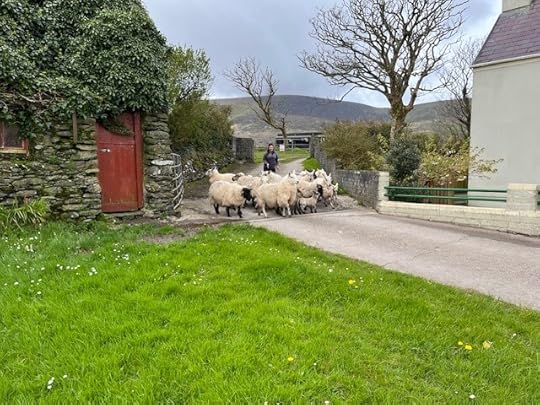
Sheep, including some baby lambs, headed for the barn.
That building is gone now. Peter told me it was crumbling when he was a teenager, and he was given the task of demolishing it with a tractor. He pointed to a large rockpile 100 yards from where we stood. “That mound of rock on the edge of the field is what remains of it,” he said. “We still use the stones from time to time. They’re good stones.” He retrieved a small one for me and presented it as a gift I’ll treasure.
Grainne described her favorite walk along the boreen to the road that leads to the Ventry Strand, the beautiful beach Baile an Chótaigh overlooks. We both feel sure my grandmother walked the same path hundreds of times before she left Ireland in 1901 at the age of twenty.
The week before we arrived, Muiris was a key organizer of a long-overdue celebration of the accomplishments of my great uncle Dennis Fenton, who won three gold and two bronze medals in the 1920 and 1924 Olympics. For more information about him, go here: https://olympics.com/en/athletes/dennis-fenton
The commemoration originally was planned for 2020, a century after the Antwerp games where he’d won his first medals, but the pandemic forced it to be postponed until this year.
About a dozen of my cousins from Massachusetts were on hand April 3, the day a bench in the center of Ventry village was dedicated in his memory. Due to work schedules, we didn’t arrive until a week later, and while it was unfortunate we missed what sounded like a wonderful gathering, it was a thrill to see the beautiful memorial when we did get there.
Later in the trip we explored the countryside in Co. Mayo, where no members of my grandfather’s family remain. The last time we were in Ireland I went to the General Registry in Dublin and found my grandpa’s birth certificate, showing he was born in a townland called Bekan. That pinned it down enough for us to drive east from Westport through beautiful farmland and find a tiny village centered around an old church. I’d assumed the pronunciation of the name was Beck-an, but a lovely woman in the combination pub/store corrected me. “It’s Bacon, like Bacon and Cabbage,” she said, a mnemonic I won’t soon forget.
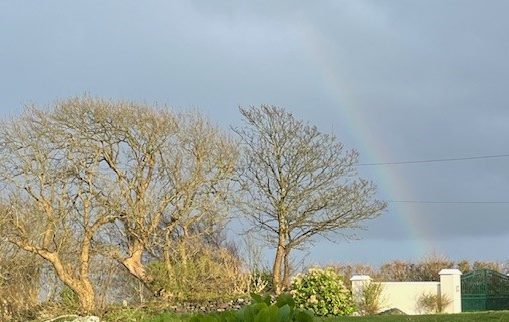
A rainbow after one of the many afternoon showers we experienced in the west of Ireland during our trip.
Coming next month: Music, history, Galway and Dublin.
Brenda Buchanan brings years of experience as a journalist and a lawyer to her crime fiction. She has published three books featuring Joe Gale, a newspaper reporter who covers the crime and courts beat. She is now hard at work on new projects. FMI, go to http://brendabuchananwrites.com
May 3, 2024
Weekend Update: May 4-5, 2024
 Next week at Maine Crime Writers there will be posts by Brenda Buchanan (Monday), John Clark (Tuesday), Joe Souza (Thursday) and Jule Selbo (Friday).
Next week at Maine Crime Writers there will be posts by Brenda Buchanan (Monday), John Clark (Tuesday), Joe Souza (Thursday) and Jule Selbo (Friday).
In the news department, here’s what’s happening with some of us who blog regularly at Maine Crime Writers:
Matt Cost will continue his series of COST TALKS. On Wednesday, May 8th, he will be at the Lincolnville Community Library at 6:30. On Friday, May 10th, Cost will be speaking at the Fryeburg Public Library at 4:00 p.m. These talks revolve around the evolution of a book from idea to promotion and everything in between with an emphasis on the recent release of Pirate Trap.
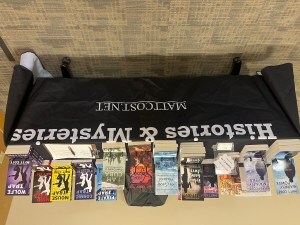
An invitation to readers of this blog: Do you have news relating to Maine, Crime, or Writing? We’d love to hear from you. Just comment below to share.
And a reminder: If your library, school, or organization is looking for a speaker, we are often available to talk about the writing process, research, where we get our ideas, and other mysteries of the business, along with the very popular “Making a Mystery” with audience participation, and “Casting Call: How We Staff Our Mysteries.” We also do programs on Zoom. Contact Kate Flora
About Lilacs – Stolen from The Orange Mailbox
Kate Flora: We are probably driving around the Yorkshire Dales as you read this, so in honor of May, and flowering things, I am cheating (as I sometimes do) and posting one of my mother’s posts from May in her collected columns: From the Orange Mailbox: Notes from a Few Country Acres. If you, like me, find bouquets of lilacs intoxicating, you will enjoy this.
From the writing of A. Carman Clark:
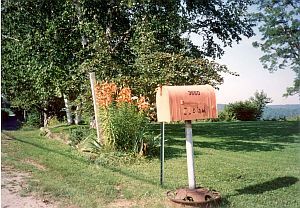
The Orange Mailbox at 1000 E. Sennebec Road.
Long ago in a New England mystery, I found a reference to lilacs as markers of old cellar holes. The city-bred heroine pursued by the murderer took to the woods and cowered behind a clump of flowering lilacs. The villain, allergic to bees, was stung and perished miserably behind the cornerstone of an old foundation. The story ended with all the threads tied up but left me with the question, “If the farm buildings had completely disintegrated, would the lilacs still bloom?”
Since moving to Maine, driving along back roads and hiking over long discontinued roadways have provided ample proof of the hardiness and tenacity of this flowering shrub. Rampant purple blossoms along wooded roads, visible among the soft greens of trees leafing out in May, do indeed indicate old cellar holes. Glimpses of purple have led to the discovery of overgrown graveyards.
Cutting lilacs was a spring ritual when the children were young. An abandoned farm up the road was lavish with lilacs, and we could cut armloads and have bouquets in every room. A lovely old gray pickle crock was the right container for a living room display. We hadn’t read about the superstitions associated with lilacs or purple. We enjoyed. It was pleasant to waken to a fragrant house.
New Englanders once believed that purple hues should not be permitted indoors. These symbolized mourning and sadness and might bring bad luck. Young women were reminded: She who wears lilac will never wear a wedding ring. Sending a bouquet of lilacs was a way of telling one’s betrothed of a wish to break off an engagement. Related, perhaps, to “In the spring, a young man’s fancy…”
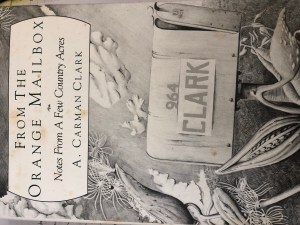 Blooming early and bountiful after winter in a climate where winters are cold—for lilacs grow as far north as Hudson Bay—this shrub was once planted beside almost every New England home. And, come spring, looking for a five-corolla-lobed lilac, like seeking a four-leaf clover, was supposed to bring good luck.
Blooming early and bountiful after winter in a climate where winters are cold—for lilacs grow as far north as Hudson Bay—this shrub was once planted beside almost every New England home. And, come spring, looking for a five-corolla-lobed lilac, like seeking a four-leaf clover, was supposed to bring good luck.
The word “lilac” comes from a Persian term for “bluish” but plant historians believe this hardy shrub was brought from the mountain slopes of southwestern China. Since only prized possessions warranted inclusion in the burden of long caravan journeys, the lilac’s transplanting suggests that fragrant early blooming has pleasured man’s sense of beauty for centuries.
By the seventeenth century lilac were a favorite in Europe and were blooming in both castle and cottage gardens in England. New Hampshire may have been the site of the first lilacs planted in America, and this is their state flower. In 1750, Benning Wentworth, colonial governor of New Hampshire, laid out a terrace to complete his rambling fifty-two-room mansion, he had lilacs brought from England.
Governor Wentworth is remembered for the beauty of his lilac shrubbery, and since he entertained often and sumptuously, his guests copied his landscaping and spring blossoms of this shrub spread up and down New England.
Wentworth is also remembered for his impulsive second marriage. After his guests had enjoyed the dinner celebrating his sixtieth birthday, Wentworth ordered the rector of St. John’s Church in Portsmouth to marry him then and there to his beautiful servant, Martha Hilton, who had just turned twenty. Martha Wentworth inherited the coastal estate and entertained George Washington there. (And some references state that the second lilacs imported to America were planted at Mt. Vernon.)
In England, the lilac was sometimes called the “pipe-tree” because the stems of pipes could easily be formed from lilac wood and a few tales suggest that the great god Pan used hollow lilac shoots instead of river reeds for the musical pipes which enticed maidens into the spring woodlands.
When Decoration Day was planned as a nation-wide observance in 1868 for the purpose of strewing flowers or otherwise decorating the graves of those who died in defense of their country during the Civil War, New England had lilacs in bloom on that date. And we still do. The color may symbolize mourning, but the fragrant blooms proclaim renewal and the strength of the life force.
May 1, 2024
The Name Game
Kaitlyn Dunnett/Kathy Lynn Emerson here, today musing about names.
Selecting the right name for each character, of course, is a crucial part of writing fiction. The name has to either fit, or deliberately not fit the character it is assigned to. Simple, right?
Not so much, especially if the writer has a backlist. Giving the same first name or surname to an important character in more than one book isn’t a great idea. If both books are part of the same series, it’s an even worse idea. Rule of thumb: do not confuse your readers.
When I was writing my Face Down series, set in sixteenth-century England, I kept a list of all the names I used in each book and short story and tried very hard not to repeat myself, even for minor characters. I also had a master list of names in use in that era, taken from history texts and genealogies. Some just sounded too modern, even though they were in use back then. Others struck me as too unusual. Still, better an odd name than the reality, which was that most of the population shared the same few first names: Anne, Mary, Jane, Elizabeth, and Catherine for women and Henry, John, Edward, Thomas, and Robert for men. Some of the odd ones? I found real women named Dowsabella, Philadelphia, Euphemia, Temperance, and Douglas, and real sixteenth-century men were named Amias, Ambrose, Manasses, Marmaduke, and Valentine. Religion entered into naming, too. Susanna was a name often chosen by Protestant parents while a girl named Ursula, Werburga, or Fridiswide was likely Catholic.

My amateur sleuth is Susanna, Lady Appleton, a Protestant
Contemporary naming can be just as tricky. Setting aside mutual agreements to use a real person’s name as the result of a charity auction, the careful writer needs to stop and think about how many people in his or her life have a particular name (first or last). If the character has traits in common with that acquaintance, it’s probably better to pick another name.
Sometimes, of course, characters name themselves and won’t accept any alternatives. Then, dear writer, you are stuck. Even if you try to change the name, you’ll end up typing it in by mistake. The Muse refuses to be messed with.
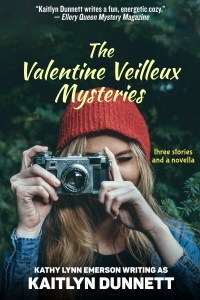
This Valentine (female) named herself.
In real life, people are often given names at birth that don’t fit them as they mature. This can be fun to play with in fiction, especially mystery fiction, where the fact that a character’s legal name is different from the one he or she is known by can be used to keep that character out of danger or plunge him or her into it.
My family tree is full of examples of people going by names other than the ones on their birth records. My grandfather, Fred Gorton, was never legally Frederick (or Alfred), although my uncle had them put Frederick on his death certificate. He did, however, add a middle initial to his signature as an adult, to distinguish himself from another Fred Gorton in the same town. He used an S with no period after it. If he had a middle name in mind, he never revealed it, but I have a sneaking suspicion that he chose the S for Scorcher, the nickname he was given as a teenager because he could ride his bike at such scorching speeds.
My other grandfather’s name was Leslie Hamilton Coburg. He went by Pat. I have no idea why. Similarly, my great-grandfather, Myron Gonzales Hornbeck was always called Miles. I have no explanation for that, either.
My father, William Russell Gorton, went by W. R. Gorton officially and was Russ to his friends. Mom was Theresa Marie but was always called Marie (although she was Mitzi to a few select pals). And me? My legal first and middle names, on the birth certificate and everything, are Kathy Lynn. That drove teachers crazy all through my schooldays. They kept insisting that Kathy had to be short for Katherine or Kathleen. I was just happy my folks didn’t go with the other name on their short list. I really cannot see myself as a Michelle.
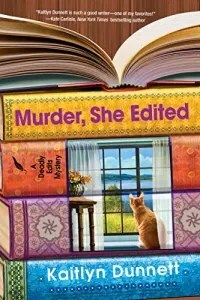
The amateur sleuth in this series, however, is named Mikki, short for Michelle
Kathy Lynn Emerson/Kaitlyn Dunnett has had sixty-four books traditionally published and has self published others. She won the Agatha Award and was an Anthony and Macavity finalist for best mystery nonfiction of 2008 for How to Write Killer Historical Mysteries and was an Agatha Award finalist in 2015 in the best mystery short story category. In 2023 she won the Lea Wait Award for “excellence and achievement” from the Maine Writers and Publishers Alliance. She was the Malice Domestic Guest of Honor in 2014. She is currently working on creating new omnibus e-book editions of her backlist titles. Her website is www.KathyLynnEmerson.com.
April 29, 2024
In Maine, it’s Mainely about the Weather!
Before I moved to Maine, I wondered why it was home to so many mystery authors. The kind who write books that rely on twists. How often have you been smugly cruising along for a chapter or so, certain you can name that villain (or the next victim) in three pages, only to have your theory come to a screeching halt. Plot Twist.
 As a writer, I know there are set places in a novel that require special attention. The inciting incident introduces the dastardly deed. The first plot point ratchets up the stakes so the amateur hero decides to get involved and the professional hero realizes something evil is afoot. Bring on plot point two where it becomes apparent to amateur and professional alike that they had the wrong end of the stick. Brace yourself for plot point three where the final bits of the puzzle fall together. The sleuths have the clues, but not the perp. Plot point four, also known as the climax, is home to the big twist. It’s the big action scene where the sleuth risks all and the bad guy bites the dust.
As a writer, I know there are set places in a novel that require special attention. The inciting incident introduces the dastardly deed. The first plot point ratchets up the stakes so the amateur hero decides to get involved and the professional hero realizes something evil is afoot. Bring on plot point two where it becomes apparent to amateur and professional alike that they had the wrong end of the stick. Brace yourself for plot point three where the final bits of the puzzle fall together. The sleuths have the clues, but not the perp. Plot point four, also known as the climax, is home to the big twist. It’s the big action scene where the sleuth risks all and the bad guy bites the dust.
I am convinced that Maine weather birthed the mystery plot structure. I know, I know, I can see those eyes rolling right through the ether. Hear me out. Early spring serves as the inciting incident. The sky blues, the trees bud, the air holds a fresh scrubbed scent. Mainers plan the garden, shake the dust from closed up homes, discover and plan repairs for winter’s toll, and survive mud season. Late spring brings the first plot point, black flies. Mainers are outdoors and under attack. Something evil is afoot so we cover ourselves in bug suits, baste our bodies with deet and move ahead with outdoor activities and fun. Summer provides plot point two. Bugs were never the issue. Enjoyment is the thing. Warm weather is fleeting. Grab it by the tail and shake it for all it’s worth.
 Plot point three arrives in the fall. Leaves turn glorious colors, days shorten, the pace of life quickens. The real enemy is fast approaching. We spend time in the woods gathering what we need. Winter can bring scarcity and beauty. Experience serves as a guide. We’ve met this enemy before, and always triumphed. This year, plot point four arrived in early March. I looked out my window and discovered a naked driveway. Most of the snow was gone from the yard and robins appeared in my backyard. I didn’t get downright giddy until I looked at the trees and spotted buds. I did what any reasonable Mainer would do. I raced to the garden store and bought supplies before they sold out. I should have known better. Two days later we had the heaviest snowfall of the season. Two feet of wet, heavy, snow. The kind that freezes on contact and leaves you with a slip and slide when you shovel. In short. Plot Twist.
Plot point three arrives in the fall. Leaves turn glorious colors, days shorten, the pace of life quickens. The real enemy is fast approaching. We spend time in the woods gathering what we need. Winter can bring scarcity and beauty. Experience serves as a guide. We’ve met this enemy before, and always triumphed. This year, plot point four arrived in early March. I looked out my window and discovered a naked driveway. Most of the snow was gone from the yard and robins appeared in my backyard. I didn’t get downright giddy until I looked at the trees and spotted buds. I did what any reasonable Mainer would do. I raced to the garden store and bought supplies before they sold out. I should have known better. Two days later we had the heaviest snowfall of the season. Two feet of wet, heavy, snow. The kind that freezes on contact and leaves you with a slip and slide when you shovel. In short. Plot Twist.
 Two more heavy snowfalls meant digging out the snowblower from the back of the garage. High winds took down power lines. It seemed the villain had the upper hand, until mother nature laughed. Let the snow fall, and the winds blow. Neither lasts long when the temps consistently top the freezing mark. The next inciting incident is on the way.
Two more heavy snowfalls meant digging out the snowblower from the back of the garage. High winds took down power lines. It seemed the villain had the upper hand, until mother nature laughed. Let the snow fall, and the winds blow. Neither lasts long when the temps consistently top the freezing mark. The next inciting incident is on the way.
 As I write this, the snow has melted. The driveway is visible, grass is greening, buds are thickening to the bursting point. It’s spring in Maine. Look out for that mud puddle. It will swallow you whole. Nothing in the north woods is free of risks.
As I write this, the snow has melted. The driveway is visible, grass is greening, buds are thickening to the bursting point. It’s spring in Maine. Look out for that mud puddle. It will swallow you whole. Nothing in the north woods is free of risks.
It seems Maine writers have been writing what they know for generations. It works because it’s true.
April 26, 2024
Weekend Update: April 27-28, 2024
 Next week at Maine Crime Writers there will be posts by Kait Carson (Monday), ??? (Tuesday), Kaitlyn Dunnett/Kathy Lynn Emerson (Thursday) and Kate Flora (Friday).
Next week at Maine Crime Writers there will be posts by Kait Carson (Monday), ??? (Tuesday), Kaitlyn Dunnett/Kathy Lynn Emerson (Thursday) and Kate Flora (Friday).
In the news department, here’s what’s happening with some of us who blog regularly at Maine Crime Writers:
Mark your calendars for this event at the York Library on May 18th:
Have you ever wondered about how crime writers create their books?
Come and hear this esteemed panel of well-established Maine Crime Writers as they share the secrets of their craft. What types of mysteries do they write, and why did they choose this genre? Do they approach writing as plotters (work from an outline), pantsers (don’t plan out anything or very little) or plansters (combination of the two)? Do they do extensive research or just make it up? And what about the development of their characters? Are they inspired by people they know? What is “Character Shopping”? Your questions will be answered, bring them all!
This program will be followed by a Q & A and a book signing. Use the link below to register:
https://yorkpl.librarycalendar.com/event/murder-our-minds-characters-plotting-and-research-9011

COST TALKS continue this week, first at the Baxter Memorial Library in Gorham on May 1st at 6:00 p.m. On Thursday, May 2nd, Matt Cost will be at the Hartland Public Library at 6:00 p.m. Come out and hear him talk about the evolution of a book from idea to promotion and everything in between with a focus on the recent release of Pirate Trap.
An invitation to readers of this blog: Do you have news relating to Maine, Crime, or Writing? We’d love to hear from you. Just comment below to share.
And a reminder: If your library, school, or organization is looking for a speaker, we are often available to talk about the writing process, research, where we get our ideas, and other mysteries of the business, along with the very popular “Making a Mystery” with audience participation, and “Casting Call: How We Staff Our Mysteries.” We also do programs on Zoom. Contact Kate Flora
Remembering the Boston Marathon Bombing
Charlene D’Avanzo: On April 15, 2013, two explosions occurred near the finish line of the Boston Marathon, killing three people and injuring over 200. An unprecedented manhunt was launched to find the perpetrators, one of whom was killed and the other was taken into custody.
Three people were killed, including an eight-year-old boy, and more than 260 were injured when twin explosions ripped through the crowds near the finish line of the Boston Marathon April 15.
Marc Fucarile was one of the victims near the finish line with a group of friends from his hometown of Stoneham when the blasts were detonated. He lost his left leg above the knee and suffered permanent hearing loss, along with shrapnel wounds and burns. His friends, brothers JP and Paul Norden, also each lost a leg.
Timeline: What Happened at the Boston Marathon Bombing

The April 15, 2013 bombing inflicted horror on a beloved Boston tradition and led to one of the most intensive manhunts in history.
Ten years ago, terrorists detonated two bombs 14 seconds apart near the finish line of the Boston Marathon. The blasts killed three people, injured nearly 300 others, shook a city, state and nation, and forever changed the lives of thousands. One Boston Day, observed every April 15, now honors the victims—including two police officers—survivors and first responders of the 2013 Boston Marathon.
Supreme Court Restores Death Sentence for Boston Marathon BomberThe Biden administration, which announced a moratorium on federal executions, has pursued the case against Dzhokhar Tsarnaev, who helped carry out the 2013 bombings.
March 4, 2022
WASHINGTON — The Supreme Court on Friday reinstated the death sentence of Dzhokhar Tsarnaev, who was convicted of helping carry out the 2013 Boston Marathon bombings that killed three and injured hundreds more.
The bombings, near the finish line of the marathon, transformed a beloved tradition into bloody carnage. The attack left 260 injured, many of them grievously. Seventeen people lost limbs.
Dzhokhar Tsarnaev and his older brother Tamerlan, Justice Thomas wrote, “each brought a backpack containing a homemade pressure-cooker bomb packed with explosives inside a layer of nails, BBs and other metal scraps.”
https://abcnews.go.com/Blotter/trial-date-set-accused-boston-marathon-bomber/story?id=22478389
Lea Wait's Blog
- Lea Wait's profile
- 509 followers



